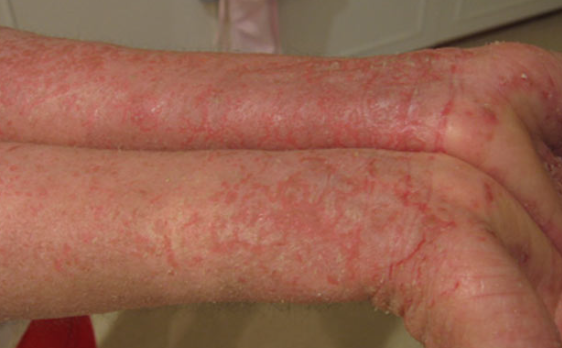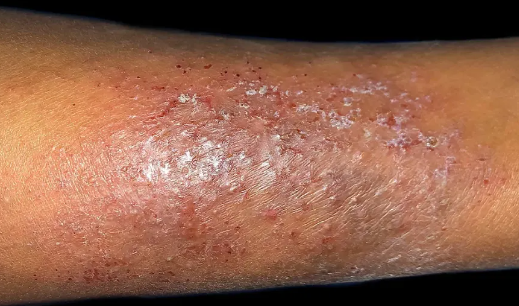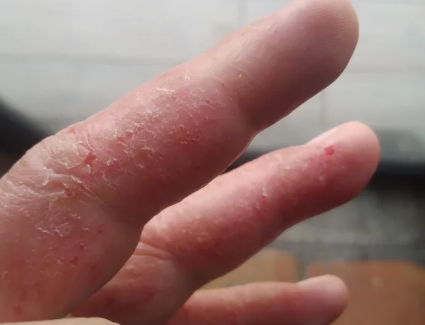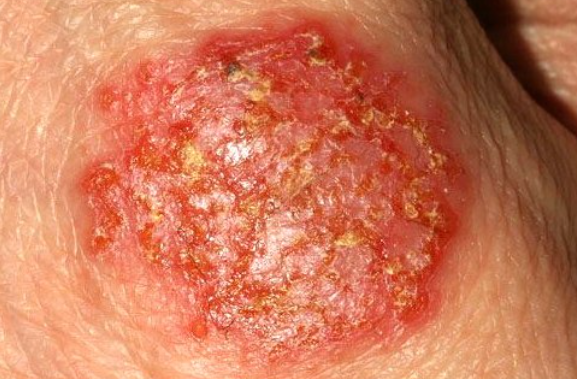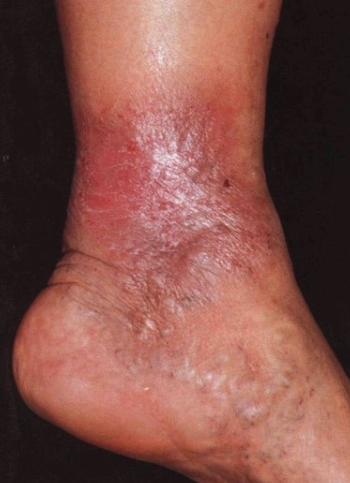Eczema is an acute or chronic recurrent allergic skin disease that develops under the influence of exogenous and endogenous triggering factors. It is characterized by the appearance of polymorphic lesions, acute inflammatory reactions caused by serous inflammation of the skin, and intense itching. ICD-10 Code: L30
Eczema develops as a result of a complex interaction of etiologic and pathogenetic factors, including neuroendocrine, metabolic, infectious-allergic and genetic factors. The disease can be triggered by exogenous factors, such as bacterial and fungal infections, chemical substances, physical factors, drugs, food, etc., as well as endogenous factors, including antigenic determinants of microorganisms from foci of chronic infection.
Genetic predisposition plays a role in immune dysregulation and the functioning of the nervous and endocrine systems. Eczema is known to have a polygenic multifactorial inheritance pattern with a high degree of gene expressivity and penetrance. If one parent (usually the mother) has the condition, the likelihood of the child developing eczema is approximately 40%, and if both parents have the condition, it can be as high as 50-60%. In the development and course of eczema, especially in children, pathologies of the gastrointestinal tract and hepatobiliary system are of significant pathogenetic importance. These may be associated with enzyme deficiencies, dyskinesias, and disorders of membrane digestion and absorption. Intestinal barrier dysfunction, which is most characteristic in early childhood, may result in the absorption of incompletely digested products, including undigested protein.
Eczema accounts for 30-40% of skin disorders.The acute stage of the disease is characterized by the appearance of vesicles, pinpoint erosions with oozing, serous crusts, excoriations, and less frequently, papules and pustules (with sterile contents) on erythematous and edematous skin. Depending on the evolution of morphological elements, several stages of eczema are distinguished: erythematous, papular, vesicular, weeping, and crusted.
The subacute stage of the disease is characterized by erythema, lichenification, scales, and excoriations.
The chronic stage of the disease is characterized by infiltration and accentuation of the skin pattern on the affected area, along with post-inflammatory hypopigmentation and hyperpigmentation.
Constant symptoms of eczema include itching, which worsens during exacerbations, burning, and tenderness in the affected areas.
Idiopathic eczema
Dyshidrotic eczema
Dyshidrotic eczema is characterized by the appearance of itchy blisters, vesicles on the lateral surfaces of the fingers of hands and feet, on palms and soles. These blisters are deep in the epidermis and can be seen through it, resembling grains of boiled rice. After rupture of the blisters with dense covers, erosions with oozing and serous crusts, cracks and scaling develop.
Tylotic form of dyshidrotic eczema. Manifests as hyperkeratosis of the palms and soles, sometimes with deep, painful fissures. It is chronic and often resistant to treatment.
Nummular eczema
Stasis dermatitis
Nipple eczema
Occupational eczema
Diagnosis is based on the patient's history and clinical presentation of the disease.
Laboratory tests:
- Complete blood count and urinalysis.
- Blood biochemistry (ALT, AST, triglycerides, creatinine, total bilirubin, glucose, etc.).
- Determination of the total IgE level in serum
- Determination of specific IgE/IgG antibodies to food, household antigens, antigens of plant, animal, and chemical origin.
- In the case of secondary infection - culture examination for the identification of the pathogen and determination of its sensitivity to antibiotics.
Idiopathic eczema
- Atopic dermatitis
- Drug eruption condition
- Bacterial infections
- Allergic contact dermatitis
Dyshidrotic eczema
- Palmoplantar psoriasis
- Tinea pedis (athlete's foot)
- Acrodermatitis continua of Hallopeau
- Bullous pemphigoid
- Herpetic whitlow
Nummular eczema
- Large plaque parapsoriasis
- Pityriasis rosea
- Tinea corporis
Treatment Goals
- Stop disease progression.
- Reduce itching.
- Resolve skin eruptions.
- Prevent recurrences.
Systemic Therapy
Antihistamine Drugs
- Loratadine 10 mg orally once a day for 10-20 days or
- Cetirizine 10 mg orally once a day for 10-20 days or
- Levocetirizine 5 mg orally once a day for 10-20 days or
- Desloratadine 5 mg orally once a day for 10-20 days or
- Clemastine 1.0 mg orally twice a day or 2.0 mg intravenously or intramuscularly twice a day for 10-20 days or
- Mebhydroline 100 mg orally twice a day for 10-20 days or
- Fexofenadine 120-180 mg orally once a day for 10-20 days.
Glucocorticoids are used in cases of inflammation:
- Betamethasone sodium phosphate + betamethasone dipropionate 2.0 mg/5.0 mg (1.0 ml) intramuscularly once (if necessary, repeated after 10 days, but not more than 2 injections) or
- Prednisone 25-30 mg per day orally for 5-25 days; when prescribed for more than 7 days, gradually reduce the dose by 5.0 mg every 5 days until complete discontinuation of the drug or
- Dexamethasone 0.004-0.008 mg (1.0-2.0 ml) per day for 3-7 days.
In cases of severe itching, tranquilizers with antihistaminic action are prescribed:
- Hydroxyzine 25 mg orally 2-4 times a day for 3-4 weeks.
In the presence of secondary infection, lymphangitis, lymphadenitis, and fever, antibiotics are used:
- Ampicillin + clavulanic acid 875 mg + 125 mg orally twice a day or 500 mg + 125 mg orally three times a day for 7-10 days or
- Doxycycline 200 mg initially, then 100 mg orally twice a day for 7-10 days or
- Levofloxacin 250 mg or 500 mg orally once or twice a day for 5-7 days or
- Ofloxacin 200 mg orally twice a day for 5-7 days or
- Cefazolin 1.0 g intramuscularly twice a day for 7-10 days or
- Ciprofloxacin 250-500 mg orally twice a day for 5-7 days.
- Ceftriaxone 1.0-2.0 g intramuscularly once a day for 7-10 days or
Topical therapy:
Wet sompresses with a 2% solution of boric acid, 0.25% solution of silver nitrate, applied 1-2 times a day for 4-7 days during the acute stage of eczema.
Topical Glucocorticoids:
- Betamethasone valerate, cream, ointment 0.1% applied once a day for 7-20 days or
- Betamethasone dipropionate, cream, ointment 0.025%, 0.05% applied twice a day for 7-14 days or
- Hydrocortisone 17-butyrate, cream, ointment 0.1% applied twice a day for 2-4 weeks or
- Clobetasol propionate, cream, ointment 0.05% applied twice a day for 7-10 days or
- Methylprednisolone aceponate, cream, ointment 0.1% applied once a day for 2-4 weeks or
- Mometasone furoate, cream, ointment 0.1% applied once a day for 2-4 weeks or
- Alclometasone dipropionate, cream, ointment 0.05% applied 2-3 times a day for 10-20 days.
Combined products:
- Gentamicin + Betamethasone + Clotrimazole applied topically twice a day for 7-14 days or
- Betamethasone + Gentamicin applied topically twice a day for 7-14 days or
- Neomycin + Natamycin + Hydrocortisone applied topically 2-4 times a day for 7-14 days or
- Betamethasone + Fusidic acid applied topically twice a day for 7-14 days or
- Hydrocortisone + Fusidic acid applied topically twice a day for 7-14 days.
Phototherapy:
- Narrowband ultraviolet therapy with a wavelength of 311 nm, administered 4-5 times a week, for a course of 25 to 30 sessions.
- Low-intensity laser therapy with red spectrum wavelength of 0.632 µm and infrared with a wavelength of 0.8-1.2 µm, for a course of 15-20 sessions in cases of localized forms.
- PUVA therapy: administered 4 times a week for a course of 15-20 sessions (in severe cases with widespread eruptions).
Prevention:
The lifestyle of a person with eczema includes avoiding contact with potential allergens, reducing stress, limiting exposure to water, and using moisturizers, emollients, and neutral detergents for prevention. Clothing should not cause overheating and should not contain wool or synthetic components. Indoor air should be humidified. In eczema prevention, the most important tasks are proper skin care and minimizing factors that lead to flare-ups.

